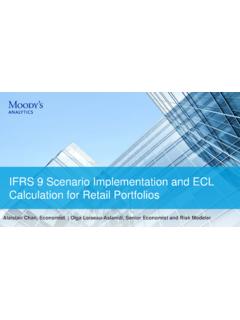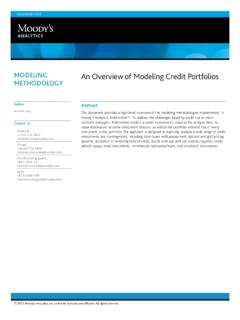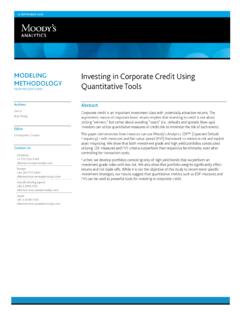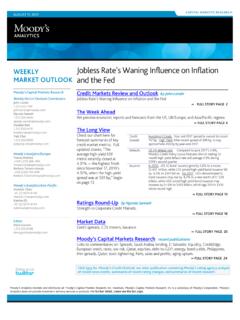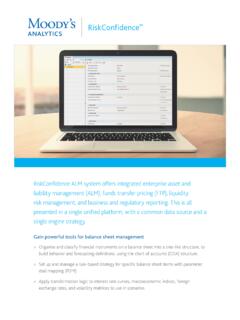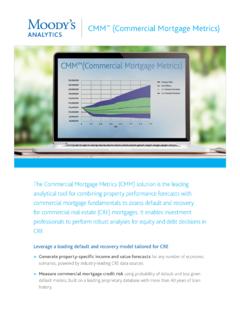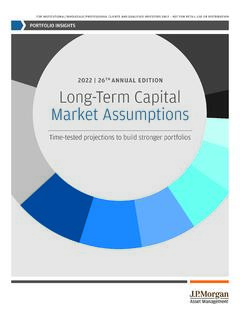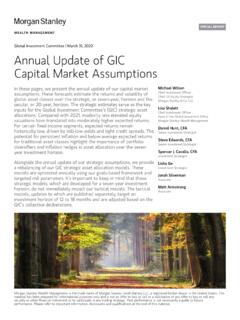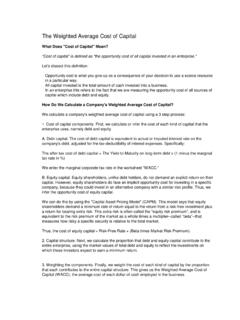Transcription of Basel III Capital and Liquidity Standards - FAQs
1 1 MOODY S ANALYTICS ENTERPRISE RISK SOLUTIONS Basel III Capital and Liquidity Standards - FAQs1. What are the Basel III Capital and Liquidity Standards ?Compared to the earlier Basel I and II frameworks, Basel III proposes many additional Capital , leverage and Liquidity Standards to strengthen the regulation, supervision and risk management of the banking sector. The Capital Standards and additional Capital buffers require banks to hold more Capital , and higher quality of Capital , than under the earlier Basel II rules. The leverage ratio introduces a non-risk based measure to supplement the risk-based minimum Capital requirements. The Liquidity ratios ensure that adequate funding is available during periods of IIPILLAR IMinimumCapitalRequirementsPILLAR IISupervisoryReviewProcessPILLAR IIID isclosure & MarketDisciplineBasel IIIPILLAR IEnhanced Minimum Capital & LiquidityRequirementsPILLAR IIEnhanced Supervisory Review Process for Firm-wide Risk Management and Capital PlanningPILLAR IIIE nhanced Risk Disclosure & Market DisciplineBasel III strengthens the three Basel II pillars, especially pillar 1 with enhanced minimum Capital and Liquidity requirements2.
2 What are the key elements of the new regulations?The new regulations raise the quality, consistency and transparency of the Capital base and strengthen the risk coverage of the Capital framework. The major elements of the proposals are noted ELEMENTPROPOSED REQUIREMENTH igher Minimum Tier 1 Capital Requirement Tier 1 Capital Ratio: increases from 4% to 6% The ratio is set at from 1 January 2013, from 1 January 2014 and 6% from 1 January 2015 Predominance of common equity will now reach of Tier 1 Capital , inclusive of Capital conservation bufferCapital Conservation Buffer Used to absorb losses during periods of financial and economic stress Banks will be required to hold a Capital conservation buffer of to withstand future periods of stress bringing the total common equity requirement to 7% ( common equity requirement and the Capital conservation buffer)
3 In 2013 The Capital conservation buffer must be met exclusively with common equity Banks that do not maintain the Capital conservation buffer will face restrictions on payouts of dividends, share buybacks and bonusesCountercyclical Capital Buffer A countercyclical buffer within a range of 0% - of common equity or other fully loss absorbing Capital will be implemented according to national circumstances When in effect, this is an extension to the conservation buffer and so could result in a common equity requirement of as much as 9% in 2013 ( common equity requirement, plus Capital conservation buffer, plus Capital buffer)ENTERPRISE RISK SOLUTIONS2 MOODY S ANALYTICS ENTERPRISE RISK SOLUTIONS Basel III Capital and Liquidity Standards - FAQsREGULATORY ELEMENTPROPOSED REQUIREMENTH igher Minimum Tier 1 Common Equity Requirement Tier 1 Common Equity Requirement: increase from 2% to The ratio is set at from 1 January 2013, 4% from 1 January 2014 and from 1 January 2015 Liquidity Standard Liquidity Coverage Ratio (LCR): to ensure that sufficient high quality liquid resources are available for one month survival in case of a stress scenario.
4 Phased introduction from 1 January 2015 Net Stable Funding Ratio (NSFR): to promote resiliency over longer-term time horizons by creating additional incentives for banks to fund their activities with more stable sources of funding on an ongoing structural basis Additional Liquidity monitoring metrics focused on maturity mismatch, concentration of funding and available unencumbered assetsLeverage Ratio A supplemental 3% non-risk based leverage ratio which serves as a backstop to the measures outlined above Parallel run between 2013-2017; migration to Pillar 1 from 2018 Minimum Total Capital Ratio Remains at 8% The addition of the Capital conservation buffer increases the total amount of Capital a bank must hold to of risk-weighted assets, of which must be tier 1 Capital Tier 2 Capital instruments will be harmonized; tier 3 Capital will be phased outSource: Bank for International Settlements, Basel Committee on Banking What is the impact on Capital requirements?
5 Capital requirements are progressively and significantly increased and the cost of Capital should be closely monitored. The diagram below demonstrates that increasing Capital ratios (Core Tier 1, Tier 1, Conservation buffer, Countercyclical buffer), stricter rules on eligible Capital and higher Capital requirements (RWA increase for some asset classes) are driving this RatiosEligible CapitalRisk Weighed AssetsThe diagram below outlines how the Basel III minimum add-on, conservation buffer and counter-cyclical buffer will affect the core, tier 1 and tier 1+ 2 II vs. Basel III Capital Ratios Tier 1 RatioTier 1 RatioTier 1 + Tier 2 Ratio+ 0 to + + + 2%4%6%+ + 0 to + 0 to + , depends oncounterparties countries Basel III Countercyclical BufferBasel III Conservation BufferBasel III Minimum Add-onBasel II Minimum ENTERPRISE RISK SOLUTIONS MOODY S ANALYTICS 34.
6 What are the major changes to credit risk and counterparty credit risk? Basel III introduces Capital requirements to cover Credit Value Adjustment risk and higher Capital requirements for securitization products. Derivatives and Repos cleared through Central Clearing Parties (CCPs) are no longer risk-free and have a 2% risk weight and clearing members shares in CCPs default funds shall be capitalized. Additionally, Basel III introduces a higher correlation factor (applicable to internal ratings based approaches) to risk weight large and unregulated financial institutions and changes concerning collateral eligibilities and haircuts What does the new framework look like?The diagram below outlines the major differences between Basel II and Basel III. It is important to note that Basel III is a fundamental overhaul of Basel II, with many elements of the regulation being updated.
7 Basel III - FrameworkPillar ICapital RatiosLiquidity RatiosLeverage RatioPillar IISupervisoryReview ProcessPillar IIIM arket Discipline(Reporting)CapitalRWALCRNSFRTi er 1 Tier 2 Concentration(EU Large Exposure)StandardCEMEPEIMAVARS tressed VARIRCC reditCCRD erivativeExposureCVAWWRS tandardIRB FIRB ABIAS tandardAMAB asel III FrameworkMarketOperationalBrand new with Basel IIIU pdated with Basel IIIU pdated with Basel Change from Basel II6. What are the main challenges of the new Basel III Liquidity risk requirements?Regulatory Liquidity risk reports will have to be produced at least monthly with the ability, when required by regulators, to be delivered weekly or even daily. This is challenging banks to put in place robust automated reporting solutions to meet this first challenge banks will face is to consolidate clean exposures, liabilities, counterparties and market data in a centralized risk data platform.
8 All portfolios contractual and behavioural cash flows should be made available and banks should have the ability to stress those and produce Liquidity gap analysis according to various scenarios. LCR buffer eligibility and haircut rules rely on external ratings, Basel classification of counterparties and standardized credit risk weights. The LCR numerator run-off rates as well as NSFR, Available Stable Funding and Required Stable Funding factors also depend on such information, usually only available in risk specific next challenge banks face is interfacing or merging their current risk and finance systems to meet the new Basel III Liquidity Risk ratio requirements. The funding concentration monitoring requirement will require banks to put in place a clean hierarchical referential of counterparties for consolidating their liabilities.
9 Different LCR ratios will have to be produced per consolidation level and currencies. As it is already the case for credit risk rules, international banks will have to cope with various national discretions and local flavors for such new Liquidity ratio rules and will have to generate various kinds of Liquidity risk regulatory reporting templates in different electronic formats per MOODY S ANALYTICS ENTERPRISE RISK SOLUTIONS Basel III Capital and Liquidity Standards - FAQs7. What is the LCR Buffer composed of?The LCR is composed of level 1 and 2 assets as outlined below:Min 60%Max 40%Application of Regulatory HaircutsThe arrow indicates that the maximumamount of Level 2 assets is calculated by applying 40% cap of liquid 1 Assets Cash Qualifying marketable securities from sovereigns, central banks, public sector entities, and multilateral development banks Qualifying central bank reserves Domestic sovereign or central bank debt in domestic currency Domestic soveriegn debt for non-0% risk weighted sovereigns, issued in foreign currencyLevel 2 Assets Sovereign, central bank and PSE assets qualifying for 20% risk weighting Qualifying corporate bonds rated AA- or higher Qualifying covered bonds rated AA- or higher8.
10 Which banks will be affected?The new Basel III regulations will affect all banks, however the severity of the impact will differ according the the type, scale and location of banks will be impacted by the increase in quantity and quality of Capital , Liquidity and leverage ratios, as well as the enhanced requirements for pillar 2 and Capital preservation. Most sophisticated investment banks will be affected by the amended treatment of counterparty credit risk, the more robust market risk framework and to some extent, the amended treatment of Systemically Important Banks (G-SIBs) are subject to higher core tier 1 Capital What are the key dates?The Basel Committee has outlined phase-in arrangements outlined below. Specific implementation timelines for individual countries, both members and non-members of the Basel Committee on Banking Supervision, may vary.
